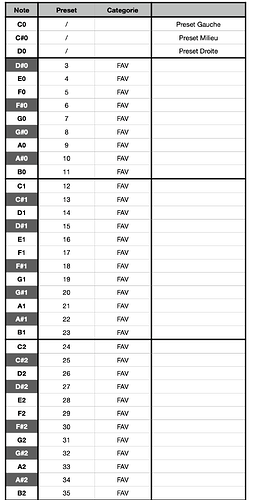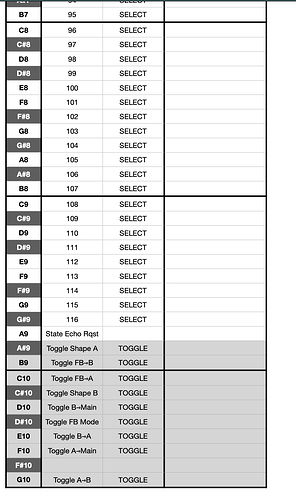I’m finally going to do a live show with my Hypno in a few weeks time and I’ve been preparing everything. Elektron Octatrack is my master controller and it’s playing nice with the Hypno using a CME MIDI Bud. I’m very excited to finally leave the laptop at home for a live show and will be triggering videos and modulating the hypno via MIDI.
*First question is on MIDI key assignments and presets. *
The MIDI guide says that notes from C scale (I’m assuming that means white notes) can be assigned to patches. I’ve tried using the black notes and successfully saved presets to those notes. Since they’re simply MIDI note numbers I assumed it would work. The MIDI guide also says that F# G# and A# are intended for controlling the 3 front buttons on the Hypno. However I’ve stored patches using those 3 notes which is great but I didn’t expect it to work.
I think I’ve found the answer but pasting it here in case it helps someone else.
While digging in the MIDI section of the manual I spotted the ’ Toggle A Shape’ MIDI Note command which suggests that MIDI Notes 118, 121 and 123 are reserved for the 3 front buttons.
I spotted also that Note 117 is reserved to request Hypno current state.
Also, 119, 120, 122, 124, 125, 127 are reserved for Button Patching.
My second question was how do I take a shape out of the output image?. It is mentioned in the Button Patching video but it passes too quickly and the buttons are obscured so I couldnt’ figure it out. But while digging in the MIDI section of the manual I spotted the ‘Toggle A->Main’ & ‘Toggle B->Main’ MIDI note commands. Which answers my question. Saving it here for anyone who searches in the future.
2 Likes
Maybe it is a bug or unexpected behavior. I should mention that C# and D# also work to save patch presets.
For the second question, do you mean how to “mute” an oscillator via MIDI only? If so, then that explanation gives me a creative idea, so thank you for posting that explanation here.
In terms of how to do it on the unit itself, while holding down an Osc button (for example, the left one), then the lights on the Hypno indicate the following:
- The top light indicates whether or not the Osc is “muted” (or hidden). Green means visible, red means hidden, and you press the top button to select between the two.
- The right light indicates if Osc A is feeding / modulating Osc B. Green means yes, red means no, and the button on the right selects between the two. The slider on the right adjusts the modulation amount.
For the other Osc, just flip the directions.
1 Like
The F#/G#/A# notes used to be only for controlling the panel switch functions, but it looks like you are in the latest firmware, so I think the sentence you’re refering to is from a previous version 
Now they store presets and notes from A#9(note 118) on are used to toggle functions, as you saw in the manual.
I’ve done a template spreadsheet for keeping track all I do within Hypno, if that can help you in any way, here are screenshots :
I also talked about how I use Hypno with Digitakt on a topic (it’s a bit outdated, I now use DT2 and Hypno with v2.4)
1 Like
Thanks both.
What I’ve learned is that the old guides/videos are probably a little out of date or not quite precise. Only one set of F# G# A# notes will control front panel buttons: specifically MIDI Note Numbers 118, 121, 123. Depending on your manufacturer those might be F#7, G#7 & A#7 or F#8, G#8 & A#8 (see note below).
For users not familiar with MIDI it may be a little confusing at first. Ideally we should refer to MIDI Note Numbers rather than the note name and octave.
The octave number is not consistent by manufacturer. Example: MIDI Note Number 118 on my Arturia controller is note A#7 but on my Elektron Octatrack it is A#8. It depends whether the manufacturer uses C3 or C4 as ‘middle C’.
I made an excel template using the PDF format shared here. I’ll share in reply to this message.
If I was clever I’d write an app to interpret the json files and edit the presets. After this show is done I’m going to try editing the json files with bbedit so that I can quickly populate presets using a lot of video files. Faster than manually doing it on the hypno. I’m also curious to see what would happen if I set zero values for each parameter in one of the json files. It could be a quick way to get a basic preset without wondering if patching/cross modulation etc was happening elsewhere in the patch.
Here is an excel file which users might find useful. Hypno Excel Template
1 Like
Hey there,
Long time lurker, first time poster. Like you, @Circuit3 , I’m also gigging with a master controller-I’m using the Akai Force, and Hypno. I didn’t want to muddy up the forum with another post about MIDI and Hypno, so thought to add a query here to see if anyone can help me:
I’ve noticed using hardware midi (Force midi out to CME H4MIDI interface to Hypno via USB), there seems to be a lag between note on and note off from Force to Hypno. When I single tap a note to recall a preset, I will see the Hypno take more noticeable time between switching patches by seeing all three LEDs light up white like it’s trying to save a patch, and then switching to the next patch. If I do a note sequence, I’ve had experiences with Hypno overwriting patches and a lot of midi lag, to the point that when I stop Force’s seq, the pattern will continue to run for an extended period of time. An oddball thing I noted is that this specifically occurs with notes that have presets saved. If there is no specific preset on the note, it functions normally.
However, if I’m doing any of this with the CME WIDI Bud, I have no problems whatsoever with patch loading/ sequencing - the first LED lights up briefly, the next patch comes in. Is there a step I’m missing with either machines’ settings? On the CME H4 Interface, I filtered almost everything out on its I/O, only leaving Ch. 16 open over USB, and filtering out everything that isn’t a note on/ off message or CC.
I did an additional test with my Keystep Pro, and over its USB I am not experiencing any issues with slow loading or lag between patches. Also, I did contact Akai to verify if Force is sending true Note off or 0vel Note on msgs, but per its midi monitor, it looks like it’s doing Note offs.
Hoping I’m not derailing this post too much, and also looking forward to getting some guidance!

